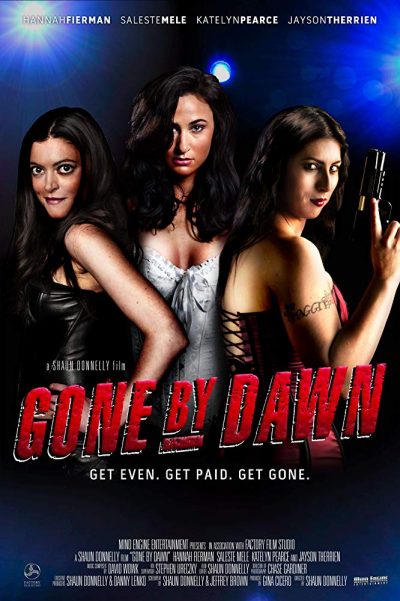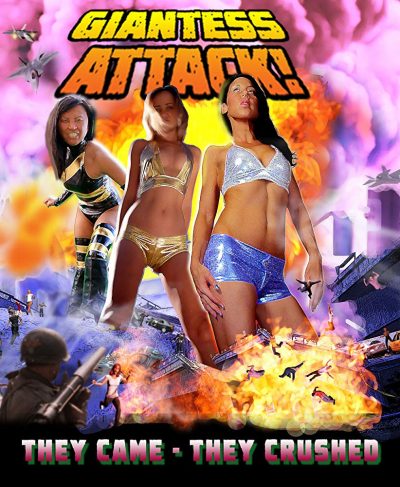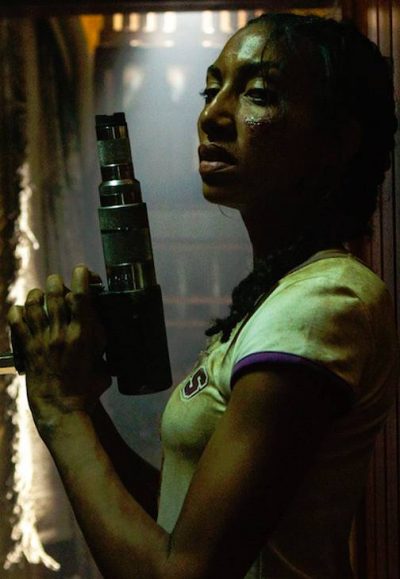★★
“Preferred this when it was called Counterfeiting in Suburbia.”
 Turns out that The Asylum are not the only company who makes mockbusters. As its alternate name makes clear, this Lifetime TVM is clearly a knock-off of the title mentioned above, down to the same, basic plot. Two teenage girls begin doing crime, largely for the excitement. A teacher becomes aware of their exploits and decides to blackmail them for his own benefit, by making them escalate their activities. This brings them increasingly under the scrutiny of both authorities and criminal elements, not to mention parental disapproval, eventually leading to a climax where all these aspects cross paths. As my review of Counterfeiting mentioned, it wasn’t even a particularly original idea there. As you can imagine, a second-generation copy is not an improvement, even if the idea of a knock-off of a movie about forgery possesses a certain irony.
Turns out that The Asylum are not the only company who makes mockbusters. As its alternate name makes clear, this Lifetime TVM is clearly a knock-off of the title mentioned above, down to the same, basic plot. Two teenage girls begin doing crime, largely for the excitement. A teacher becomes aware of their exploits and decides to blackmail them for his own benefit, by making them escalate their activities. This brings them increasingly under the scrutiny of both authorities and criminal elements, not to mention parental disapproval, eventually leading to a climax where all these aspects cross paths. As my review of Counterfeiting mentioned, it wasn’t even a particularly original idea there. As you can imagine, a second-generation copy is not an improvement, even if the idea of a knock-off of a movie about forgery possesses a certain irony.
The main twist here is that instead of counterfeiting, the crime in question is car theft. Emily (Belkin) is being brought up by her mother, after her father died in a car accident, and is working to restore her late dad’s muscle car, a task which has helped give her certain car skills, including hot-wiring them. She has teamed up with classmate Max (Helt), to boost cars, purely for joy-riding purposes, but the pair decided to make a commercial endeavour out of it, and sell the vehicles to a local chop-shop they know. Their shop teacher, Mr. Curnow (Hynes) finds out about their work, and decides to use them to start stealing high-end cars, to provide seed money for his own business involving exotic sports vehicles. This doesn’t sit well with the chop-shop owner, the cops are beginning to close in, and worst of all, Emily’s Mom is growing increasingly suspicious. When she pays Curnow a visit at his home, she is held hostage to ensure Emily completes one final task, stealing a Hummer belonging to a well-connected local club owner.
This is so painfully bland, it should have been called Barbie and Friends Do Crimes. Admittedly, I was hoping for something like a female version of a Fast and the Furious movies. As I soon as I realized this was a Lifetime TVM, all hopes of that evaporated, but it could still have avoided having less edge than a rusty butter-knife. It shoehorns in a hot teenage boy delinquent (Manley) on whom Emily can crush, largely as a means of filling time, since he serves no real plot purpose. Even the car-stealing scenes, which could have generated tension, are feeble: witness in particular the example which consists largely of one girl starting intently into her handbag, waiting for a light to go green. Hitchcock is turning in his grave. It did manage to leave me yearning nostalgically for a film which only got 2½ stars, so that’s a new experience.
While I have already written more about this than it deserves, I just discovered there is still another TVM going down the same furrow: Smuggling in Suburbia. I’ll just leave its synopsis here. mostly as a warning that the possibilities appear, sadly, endless: “Joanie gets recruited to travel with other girls to exciting cities delivering camera lenses to photographers–and falls in love with Tucker, a partner in the courier business. When she searches the camera case she’s carrying and finds diamonds hidden inside a lens, Joanie realizes she is part of an illegal smuggling ring! She just needs to pay for her brother’s cancer surgery that would otherwise bankrupt the family.” Yeah, I’m good, thanks.
Dir: Jason Bourque
Star: Zoë Belkin, Samantha Helt, Tyler Hynes, Jake Manley
a.k.a. Hotwired in Suburbia





 The life of Jill Conway (Seyfried) is slowly returning to somewhat normal, following her abduction by a serial killer in the Pacific Northwest. She was held in a forest pit, and barely managed to escape with her life. However, the lack of physical evidence and a history of mental health problems, helped cause the authorities not to believe her story. When Jill’s sister Molly vanishes, she’s certain the same killer is responsible, and when the police again fail to take her seriously, begins investigating herself. But when the cops find out this former mental patient is packing heat, Jill becomes a fugitive herself.
The life of Jill Conway (Seyfried) is slowly returning to somewhat normal, following her abduction by a serial killer in the Pacific Northwest. She was held in a forest pit, and barely managed to escape with her life. However, the lack of physical evidence and a history of mental health problems, helped cause the authorities not to believe her story. When Jill’s sister Molly vanishes, she’s certain the same killer is responsible, and when the police again fail to take her seriously, begins investigating herself. But when the cops find out this former mental patient is packing heat, Jill becomes a fugitive herself. I decided I might as well combine these two into a single review. Having watched them back-to-back, even though made and set three years apart, they felt very much like the continuation of a single story about the same characters. The main one is Roxy (Mele), who is a dancer at a Wisconsin strip-club run by the sleazy Stag (Therrien), mostly as a money-laundering front for local organized crime. When he and his pal rape an employee, Alana (Pearce), Roxy along with the victim and another dancer, Crystal (Fierman), decide to take revenge by robbing Stag. That means getting into the safe in his office where the money is, and he’s not exactly going to give up the combination freely. Still, nothing that a piano-wire garrotte round the testicles can’t solve, surely? Except, as usual in this genre, the heist doesn’t go smoothly. Stag’s office quickly begins to resemble a mortuary, as unwelcome guests need to be handled.
I decided I might as well combine these two into a single review. Having watched them back-to-back, even though made and set three years apart, they felt very much like the continuation of a single story about the same characters. The main one is Roxy (Mele), who is a dancer at a Wisconsin strip-club run by the sleazy Stag (Therrien), mostly as a money-laundering front for local organized crime. When he and his pal rape an employee, Alana (Pearce), Roxy along with the victim and another dancer, Crystal (Fierman), decide to take revenge by robbing Stag. That means getting into the safe in his office where the money is, and he’s not exactly going to give up the combination freely. Still, nothing that a piano-wire garrotte round the testicles can’t solve, surely? Except, as usual in this genre, the heist doesn’t go smoothly. Stag’s office quickly begins to resemble a mortuary, as unwelcome guests need to be handled. I didn’t think the sequel worked as well. While Roxy returns, she has been recast, being now played by Matheis – I’m not sure what happened to Mele. Still, I did laugh when one supporting character greets her with, “You look different!” Oddly, while the first film started with Roxy skipping town, the second sees her back, working at the same venue where she was involved in a multiple homicide. I know strippers are renowned for making poor decisions, but still… It turns out, having absconded with nine hundred grand of the mob’s money isn’t a good idea. They want it back, and to this end, have sent a trio of hired killers, named the Three Bears by Roxy. They’re prepared to do anything, up to and including both kidnapping and murder. But Roxy, along with Jesse (Radzion), a friend of Alana’s, and another dancer, Alura (Laventure), plots to turn the tables on the Three Bears, by robbing their boss.
I didn’t think the sequel worked as well. While Roxy returns, she has been recast, being now played by Matheis – I’m not sure what happened to Mele. Still, I did laugh when one supporting character greets her with, “You look different!” Oddly, while the first film started with Roxy skipping town, the second sees her back, working at the same venue where she was involved in a multiple homicide. I know strippers are renowned for making poor decisions, but still… It turns out, having absconded with nine hundred grand of the mob’s money isn’t a good idea. They want it back, and to this end, have sent a trio of hired killers, named the Three Bears by Roxy. They’re prepared to do anything, up to and including both kidnapping and murder. But Roxy, along with Jesse (Radzion), a friend of Alana’s, and another dancer, Alura (Laventure), plots to turn the tables on the Three Bears, by robbing their boss. Make no mistake,
Make no mistake,  Many of the changes are relatively small – tweaks, rather than significant changes. For instance, rather than the landlady having a dog, Liang herself has a cat. Though in a morbid twist, she feeds her kitty some of the remnants of her victim. The gang attack is preceded by a battle between two different groups, both of whom have tracked Liang to a deserted Hong Kong park: the winners get… Well, gunned down by her. There is,
Many of the changes are relatively small – tweaks, rather than significant changes. For instance, rather than the landlady having a dog, Liang herself has a cat. Though in a morbid twist, she feeds her kitty some of the remnants of her victim. The gang attack is preceded by a battle between two different groups, both of whom have tracked Liang to a deserted Hong Kong park: the winners get… Well, gunned down by her. There is, 
 Harry Potter, this is
Harry Potter, this is  I’ll confess, the headline above is a bit click-baity. This is perhaps closer to a female version of The Frighteners, the early Peter Jackson film in which Michael J. Fox could see dead people, and had to learn to work with them. The conduit in this case is Rika (Yanagi), a young woman who has been able to see ghosts since a young age. But an encounter with a trio of ghosts, all murder victims who are seeking revenge on their killers, opens a whole new realm. For, it turns out, whenever Rika is in a life-threatening situation, the spirits can take physical form. They can also draw energy from her, which can be used to create weapons, which range from the merely strange (the “meat hammer”) to the bat-shit insane. None more so there, than that of Akari (Mikado). She has a tendency to go into puppy mode when stressed, which involves her becoming… a bit licky. So inevitably her weapon transforms Akari’s hand into Grudge Dog, capable of ripping the face off her opponent.
I’ll confess, the headline above is a bit click-baity. This is perhaps closer to a female version of The Frighteners, the early Peter Jackson film in which Michael J. Fox could see dead people, and had to learn to work with them. The conduit in this case is Rika (Yanagi), a young woman who has been able to see ghosts since a young age. But an encounter with a trio of ghosts, all murder victims who are seeking revenge on their killers, opens a whole new realm. For, it turns out, whenever Rika is in a life-threatening situation, the spirits can take physical form. They can also draw energy from her, which can be used to create weapons, which range from the merely strange (the “meat hammer”) to the bat-shit insane. None more so there, than that of Akari (Mikado). She has a tendency to go into puppy mode when stressed, which involves her becoming… a bit licky. So inevitably her weapon transforms Akari’s hand into Grudge Dog, capable of ripping the face off her opponent. Early 20th-century pulp-fiction author Howard Philips Lovecraft created a substantial corpus of writing, mainly in the short story format and mostly in the form of horrific science fiction which in many ways reads like classic supernatural fiction. The most enduring body of his work has been the novellas and stories making up what has come to be called his Cthulhu Mythos, based on the premise that the prehistoric Earth was dominated by the Great Old Ones, or Elder Gods, malevolent and repulsive, but very powerful and dangerous, alien beings who were ultimately dethroned by another alien race, and whose hidden remnants want to regain their past dominance. A number of Lovecraft works present the idea that these beings have an evil and often murderous cult of human worshipers, handed down from the dawn of mankind, who seek to further their return to power. Numerous later writers have been inspired by HPL’s example to create their own pastiches and spin-offs of the Mythos. Brent Nichols’ self-published Gears of a Mad God novella series (there are six in all), of which this book –set in Canada in May 1921, mainly on Vancouver Island– is the opener, is one of these spin-offs. One of my Goodreads friends gave this one a favorable review; and since I’m a Lovecraft fan and the novella is free for Kindle and relatively short at 98 pages, I downloaded it.
Early 20th-century pulp-fiction author Howard Philips Lovecraft created a substantial corpus of writing, mainly in the short story format and mostly in the form of horrific science fiction which in many ways reads like classic supernatural fiction. The most enduring body of his work has been the novellas and stories making up what has come to be called his Cthulhu Mythos, based on the premise that the prehistoric Earth was dominated by the Great Old Ones, or Elder Gods, malevolent and repulsive, but very powerful and dangerous, alien beings who were ultimately dethroned by another alien race, and whose hidden remnants want to regain their past dominance. A number of Lovecraft works present the idea that these beings have an evil and often murderous cult of human worshipers, handed down from the dawn of mankind, who seek to further their return to power. Numerous later writers have been inspired by HPL’s example to create their own pastiches and spin-offs of the Mythos. Brent Nichols’ self-published Gears of a Mad God novella series (there are six in all), of which this book –set in Canada in May 1921, mainly on Vancouver Island– is the opener, is one of these spin-offs. One of my Goodreads friends gave this one a favorable review; and since I’m a Lovecraft fan and the novella is free for Kindle and relatively short at 98 pages, I downloaded it. 2020’s first seal of approval goes to this uber-gritty Irish film, starring Sarah Bolger, whose most familiar to us from Into the Badlands. While her GWG creds there are overshadowed by the likes oE Emily Beecham, safe to say Bolger makes up for lost time here. She plays single mother Sarah Collins, who is struggling to come to terms with the recent, unsolved murder of her husband. Barely managing to make ends meet, her life is upended when entry-level criminal Tito (Simpson) breaks in, seeking sanctuary. He has stolen some drugs belonging to top boss Leo (Hogg), and offers Sarah a cut of the proceeds if she’ll act as his safe-house. Very reluctantly, she agrees. Needless to say, it doesn’t go as they plan.
2020’s first seal of approval goes to this uber-gritty Irish film, starring Sarah Bolger, whose most familiar to us from Into the Badlands. While her GWG creds there are overshadowed by the likes oE Emily Beecham, safe to say Bolger makes up for lost time here. She plays single mother Sarah Collins, who is struggling to come to terms with the recent, unsolved murder of her husband. Barely managing to make ends meet, her life is upended when entry-level criminal Tito (Simpson) breaks in, seeking sanctuary. He has stolen some drugs belonging to top boss Leo (Hogg), and offers Sarah a cut of the proceeds if she’ll act as his safe-house. Very reluctantly, she agrees. Needless to say, it doesn’t go as they plan. Diedre (Tacosa) and Frida (Riley) are the fractious stars of low-rent superhero show, Battle Babe and Combat Queen. When the series is canceled, they go on a bit of a binge, ended only by the appearance of two tiny aliens from Metaluna (Nguyen), who give the pair of very drunk Earth women devices that will turn them into Team Giantess Attack. These are intended to be used to rid the planet of evil. Needless to say, things don’t quite work out that way. The military, under Gen. Smedley Pittsburgh (Rowen), want to get their hands on this alien technology. But D+F won’t give it up and, instead, use it to go on the rampage and take revenge on those who previously wronged them.
Diedre (Tacosa) and Frida (Riley) are the fractious stars of low-rent superhero show, Battle Babe and Combat Queen. When the series is canceled, they go on a bit of a binge, ended only by the appearance of two tiny aliens from Metaluna (Nguyen), who give the pair of very drunk Earth women devices that will turn them into Team Giantess Attack. These are intended to be used to rid the planet of evil. Needless to say, things don’t quite work out that way. The military, under Gen. Smedley Pittsburgh (Rowen), want to get their hands on this alien technology. But D+F won’t give it up and, instead, use it to go on the rampage and take revenge on those who previously wronged them.